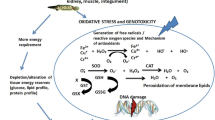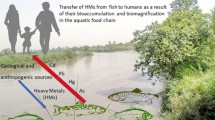Abstract
The aim of this study was to investigate the possible influence of environmental exposure to cadmium (Cd) on the spinal deformities occurrence in the Mediterranean killifish, Aphanius fasciatus (Pisces: Cyprinodontidae). For this purpose, some indicators of skeletal bone mineralization, Cd, and calcium (Ca) concentrations in spinal column as well as bioaccumulation of Cd from the water and the sediment have been compared in normal and deformed fish collected from polluted (S1) and nonpolluted (S2) areas in the Gulf of Gabès in Tunisia. When compared to the normal fish, the deformed fish showed signs of spinal column demineralization such as significant decrease in the ash weight/dry weight ratio, percentage of nonorganic components content, and Ca concentration. Cd concentrations in spinal column and liver were significantly higher in deformed fish than in normal fish. A highly significant negative correlation (r = −0.915, p < 0.01) between Cd and Ca concentrations was noted in spinal column of deformed fish. Bioaccumulation factors of Cd in the liver from the water and the sediment in deformed fish were also significantly higher (p < 0.0001) than in normal fish from S1 and S2. These findings suggest that the ability to accumulate large amount of Cd may represent a potential risk to induce spinal deformities in natural populations of Mediterranean killifish.



Similar content being viewed by others
References
Boumaïza M, Quinard J, Ktari M (1979) Contribution à la biologie de la reproduction d’Aphanius fasciatus Nardo, 1827 (Pisces: Cyprinodontidae) de Tunisie. Bull Off Natl Pesches Tunis 3:221–240
Villwock W (1982) Aphanius (Nardo, 1827) and Cyprinodon (Lac., 1803) (Pisces: Cyprinodontidae), an attempt for genetic interpretation of speciation. Z Zoolog Syst Evol forsch 20:187–197
Leonardos I, Sini A (1999) Population age and sex structure of Aphanius fasciatus Nardo, 1827 (Pisces: Cyprinodontidae) in the Mesonlogi and Etolikon lagoons (W. Greece). Fish Res 40:227–235
Messaoudi I, Kessabi K, Kacem A, Saïd K (2008) Incidence of spinal deformities in natural populations of Aphanius fasciatus Nardo, 1827 from the Gulf of Gabès, Tunisia. Afr J Ecol. doi:10.1111/j.1365-2028.2008.00972.x
Hamza-Chaffai A, Pellerin JJC (2003) Health assessment of a marine bivalves Ruditapes decussatus from the Gulf of Gabès (Tunisia). Environ Int 28:609–617
Smaoui-Damak W, Hamza-Chaffai A, Berthet B, Amiard JC (2003) Preliminary study of the clam Ruditapes decussatus exposed in situ to metal contamination and originating from the gulf of Gabès, Tunisia. Bull Environ Contam Toxicol 71:961–970
Banni M, Jebali J, Daubeze M, Clerandau C, Guerbej H, Narbonne JF, Boussetta H (2005) Monitoring pollution in Tunisian coasts: application of a classification scale based on biochemical markers. Biomarkers 10:105–116
Banni M, Dondero F, Jebali J, Guerbej H, Boussetta H, Viarengo A (2007) Assessment of heavy metal contamination using real time PCR analysis of mussel metallothionein mt10 and mt20 expression: a validation along the Tunisian coasts. Biomarkers 12:369–383
Messaoudi I, Deli T, Kessabi K, Barhoumi S, Kerkeni A, Saïd K (2008) Association of spinal deformities with heavy metal bioaccumulation in natural populations of grass goby, Zosterisessor ophiocephalus Pallas, 1811 from the Gulf of Gabès (Tunisia). Env Monit Assess. doi:10.1007/s10661-008-0504-2
Slooff W (1982) Skeletal anomalies in fish from polluted surface waters. Aquat Toxicol 2:157–173
Whittle DM, Sergeant DB, Huestis SY, Hyatt WH (1992) Food chain accumulation of PCDF isomers in the Great Lakes aquatic community. Chemosphere 25:181–184
Hubbs C (1959) High incidence of vertebral deformities in two natural populations of fishes inhabiting warm springs. Ecology 40:154–155
Muramoto S (1981) Vertebral column damage and decrease of calcium concentration in fish exposed experimentally to cadmium. Environ Pollut Ser 24:125–133
Bengtsson BE, Larsson A (1986) Vertebral deformities and physiological effects in fourhorn sculpin (Myoxocephalus quadricornis) after long-term exposure to a simulated heavy metal containing effluent. Aquat Toxicol 9:215–229
Cheng SH, Wai AWK, So CH, Wu RSS (2000) Cellular and molecular basis of cadmium-induced deformities in zebrafish embryos. Environ Toxicol Chem 19:3024–3031
Pratap H, Fu H, Lock R, Bonga S (1989) Effect of waterborne and dietary-cadmium on plasma ions of the teleost Oreochromis mossambicus in relation to water calcium level. Arch Environ Contam Toxicol 18:568–575
Hwang P, Yang C (1997) Modulation of calcium uptake in cadmium-pretreated tilapia (Oreochromis mossambicus) larvae. Fish Physiol Biochem 16:403–410
Koyama J, Itazawa Y (1977) Effects of oral administration of cadmium on fish—I. Analytical results of the blood and bones. Nippon Suisan Gakkaishi 43:523–526
Larsson A, Bengtsson BE, Haux C (1981) Disturbed ion balance in flounder, Platichthys flesus L. exposed to sublethal levels of cadmium. Aquat Toxicol 1:19–35
Warchałowska-Śliwa E, Niklinska M, Görlich A, Michailova P, Pyza E (2005) Heavy metal accumulation, heat shock protein expression and cytogenetic changess in Tetrix tenuicornis (L.) (Tetrigidae, Orthoptera) from polluted areas. Environ Pollut 133:373–381
Bervoets L, Blust R (2003) Metal concentrations in water, sediment and gudgeon (Gobio gobio) from a pollution gradient: relationship with fish condition factor. Environ Pollut 126:9–19
Annabi A, Messaoudi I, Kerkeni A, Saïd K (2008) Comparative study of the sensitivity to cadmium of two populations of Gambusia affinis from two different sites. Environ Monit Assess. doi:10.1007/s10661-008-0448-6
Rashed MN (2001) Monitoring of environmental heavy metals in fish from Nasser Lake. Environ Int 27:27–33
Chen MH, Chen CY (1999) Bioaccumulation of sediment-bound heavy metals in Grey Mullet, Liza macrolepis. Mar Pollut Bull 39:239–244
Romeo M, Siaub Y, Sidoumou Z, Gnassia-Barelli M (1999) Heavy metal distribution in different fish species from the Mauritania coast. Sci Total Environ 232:169–175
Karadede H, Oymak SA, Ünlü E (2004) Heavy metals in mullet, Liza abu, and catfish, Siluris triostegus, from the Atatürk Dam Lake (Euphrates), Turkey. Environ Int 30:183–188
Hamza-Chaffai A, Cossin RP, Amiard-Triquet C, El-Abed A (1995) Physico-chemical forms of storage of metals (Cd-Cu and Zn) and metallothionein-like proteins in gills and liver of marine fish from the Tunisian Coast: ecotoxicological consequences. Comp Biochem Physiol 102:329–341
Hamza-Chaffai A, Amiard-Triquet C, El-Abed A (1997) Metallothionine like protein: is it an efficient biomarker of metal contamination? A case study based on fish from the Tunisian coast. Arch Environ Contam Toxicol 33:53–62
Illou S (1999) Impact des rejets telluriques d’origines domestiques et industrielles sur l’environnement côtier: cas du littoral de la ville de Sfax. Thèse de Doctorat, Université de Tunis II 259 pp
Serbaji MM (2000) Utilisation d’un SIG multi-sources pour la compréhension et la gestion intégrée de l’écosystème côtier de la région de Sfax (Tunisie). Thèse de Doctorat, Université de Tunis II 152 pp
Weiss JS, Weiss P (1989) Effects of environmental pollutants on early fish development. Aquat Sci 1:45–73
Bengtsson A, Bengtsson BE, Lithner G (1985) Vertebral defects in fourhorn sculpin, Myoxocephalus quadricornis L, exposed to heavy metal pollution in the Gulf of Bothnia. J Fish Biol 33:517–529
Buhringer H, Sperling K, Wunder W (1990) Spinal shortening (osteosclerosis) in spawners of the rainbow trout. Arch Fischwiss 40:205–228
Brzoska MM, Moniuszko-Jakoniuk J, Jurczuk M, Gałazyn-Sidorczuk M, Rogalska J (2001) The effect of zinc supply on cadmium-induced changes in the tibia of rats. Food Chem Toxicol 39:729–737
Bengtsson BE, Carlin CH, Larsson A, Svanberg O (1975) Vertebral damage in minnows, Phoxinus phoxinus exposed to cadmium. Ambio 4:166–168
Whelton BD, Peterson DP, Moretti ES, Dare H, Bhattacharyya MH (1997) Skeletal changes in multiparous, nulliparous and ovariectomized mice fed either a nutrient-sufficient or -deficient diet containing cadmium. Toxicology 119:103–121
Brzoska MM, Galażyn-Sidorczuk M, Rogalska J, Roszczenko A, Jurczuk M, Majewska K, Moniuszko-Jakoniuk J (2008) Beneficial effect of zinc supplementation on biomechanical properties of femoral distal end and femoral diaphysis of male rats chronically exposed to cadmium. Chem Biol Interact 171:312–324
Berntssen MHG, Waagbo H, Toften H, Lundebye AK (2003) Effects of dietary cadmium on calcium homeostasis, Ca mobilization and bone deformities in Atlantic salmon (Salmo salar L) parr. Aquacult Nutr 9:175–183
Simmons DJ (1971) Calcium and skeletal tissue physiology in teleost fish. Clin Orthop Relat Res 76:244–280
Moss ML (1961) Studies of the acellular bone of teleost fish. I. Morphological and systematic variations. Acta Anat 46:343–362
Moss ML (1965) Studies of the acellular bone of teleost fish. V. Histology and mineral homeostasis of fresh-water species. Acta Anat 60:262–276
Blumenthal N, Cosma V, Skyler D, Legeros J, Walters M (1995) The effect of cadmium on the formation and properties of hydroxyapatite in-vitro and its relation to cadmium toxicity in the skeletal system. Calcif Tissue 56:316–322
Suzuki Y, Morita I, Ishizaki Y, Yamane Y, Murota S (1989) Cadmium stimulates prostaglandin E2 synthesis in osteoblast-like cells. Biochem Biophys Acta 1012:135–139
Author information
Authors and Affiliations
Corresponding author
Rights and permissions
About this article
Cite this article
Kessabi, K., Kerkeni, A., Saïd, K. et al. Involvement of Cd Bioaccumulation in Spinal Deformities Occurrence in Natural Populations of Mediterranean Killifish. Biol Trace Elem Res 128, 72–81 (2009). https://doi.org/10.1007/s12011-008-8255-z
Received:
Accepted:
Published:
Issue Date:
DOI: https://doi.org/10.1007/s12011-008-8255-z




